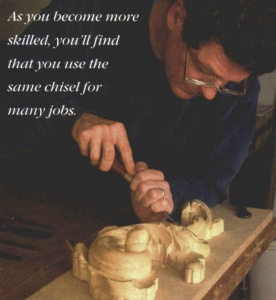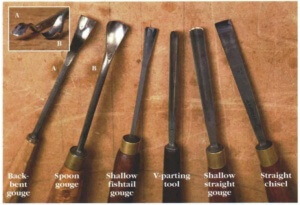Getting started doesn’t need to be confusing or cost a fortune
By Ian Agrell. Originally published in Fine Woodworking magazine #122, February 1997, pages 80-83. View or download the original article (PDF).

Woodcarver Ian Agrell. Image courtesy of Fine Woodworking magazine.
I’ve been carving wood for 34 years and teaching others for 18, so I’m often asked what tools to buy for woodcarving. My standard reply consists of a few questions of my own: What sort of carving do you want to do? What size? What woods? The answers to those questions will help determine the tools a carver will need.
A beginning carver can get by just fine with a few general-purpose tools. As a rule, I would avoid buying a prepackaged set. No matter what the quality of the tools, usually one or two are a waste of space and negate the savings of buying them as a set.
High-quality carving tools, well-looked after and properly used, will last a lifetime and more—some of mine are more than 150-years old. Buy the best, and buy just a few tools at first. You can always add more when you need them. That way, you don’t end up with tools you’ll never use.
Where to find them
Carving tools are readily available at woodworking stores and in mail-order tool catalogs. Of the current offerings, I prefer the Pfeil tools (marked “Swiss made” on their handles), distributed in the United Stated by Woodcraft (210 Wood County Industrial Park, P.O.Box 1686, Parkersburg, WV 26102-1686; 800-225-1153). I think they’re the most refined carving tools made today. This is especially obvious in the smaller sizes, which are lighter and better machined than any of the others generally available.
The second-hand market also is a useful source of tools. At any decent-sized flea market, you can usually find someone selling these tools. If you research current prices before you go tool hunting, you’re more likely to get a good deal. You should be able to find good second-hand tools for half, or less, of what they cost new. The best tools were made by Addis and Herring Bros., but neither of these companies has been in business for years.
Homemade or custom carving tools also can be superb. I have some that were made about 100 years ago. They are light, delicate and well-made. Homemade tools often can be found at flea markets and used-tool dealers right alongside the commercial offerings, or you can have them made for you (there are a number of specialty forges).
You can learn to make your own carving tools by reading toolmaking books or by attending courses on the subject. Homemade tools are an especially attractive option when you need a specific chisel for a particular carving. I have some excellent fishtails that are very handy—I’ve never seen any comparable one available commercially.
Don’t pass up chisels without handles. Making new handles is a good opportunity for you to practice some carving. If you’re not inclined to spend time carving handles, replacement handles are generally available through woodworking catalogs.

An array of common woodcarving tools. Image courtesy of Fine Woodworking magazine.
Carving tools come in a huge variety of shapes and sizes, but what you need to know is really pretty basic. I use a relatively limited range of tools, and that hasn’t impaired my carving. The types of carving tools I find most useful are straight gouges, V-parting tools, fishtail and spoon gouges.
Straight gouges are all-purpose tools that do most of a carver’s work. Depending on the profile of the gouge, which is called the section or sweep, a gouge may be used for raped stock removal, for rendering detail on a carving or for leaving a polished, finished surface in its wake. Gouges with a very high section are called veiners.
V-parting tools are used to define and separate areas of carving. Carvers make a sketch on the wood with a V-parting tool and then use a gouge to shape the carving.
Fishtail chisels and gouges are useful because they flare out from the shaft at the cutting end. They let you see the carving better (there’s less metal to block your view of the work) and allow you to get into tighter corners and more restricted areas.
Spoon gouges are essential for getting into interior curves and any deeply concave areas. I prefer spoon gouges to bent gouges, which curve gently from just in front of the handle all the way to the end of the blade. When I put pressure on a bent gouge, it’s not transmitted as directly to the end of the blade.
I don’t think flat-section (No. 1) straight chisels or back-bent gouges are essential, though I sometimes use them. Flat-section chisels are more a tool for letter carvers. Most of what a back-bent gouge does I can do by inverting a regular gouge and using the inside to cut convex shapes.
I don’t find skew chisels of much use because I have heavy, flared fishtails that can get into the same tight spaces. And I haven’t yet come across a situation in which I needed a dog-leg chisel or a macaroni tool (even though they look like they’d be fun to have).

Above: Same size, different section—Both of these carving tools are 25mm wide. The one on the right is a No. 11, the highest section (or profile) commonly made. The one on the left is a No. 1. It’s flat.
Below: The same section, different size—Both of these tools have No.5 sections, one of the most useful profiles. But one is only 5mm wide (about 3/16 inch), and the other is 35mm wide (about 1 3/8 inch). Image courtesy of Fine Woodworking magazine.
Below: The same section, different size—Both of these tools have No.5 sections, one of the most useful profiles. But one is only 5mm wide (about 3/16 inch), and the other is 35mm wide (about 1 3/8 inch). Image courtesy of Fine Woodworking magazine.
Section and size: What do the numbers mean?
Woodcarving gouges, like golf clubs, are numbered for different uses. Basically, they go from No.1 to No. 11. A No. 1 is flat, a No.2 curves slightly, a No. 3 a little more and so on to No. 11, which has a U-shape. For general carving, gouges with a No. 5 section are the most useful. Sections around No. 9 are better for going deeper. These remove wood faster, which is helpful when creating a background or roughing out a carving. Also, because their sides are steeper, they’re less likely to catch and rip the wood.
In addition to having different sections, all carving tools come in different widths. You can have a 3mm No. 5 or a 30mm No. 5 (most carving tools are sold in metric sizes). As a general rule, I tell my students to use the biggest chisel they can for any given task. The work will flow better, be cleaner (fewer tool marks) and go faster.
There are no definite rules or laws about which chisel does what. Trying to find this information is like searching for the meaning of life, except less rewarding. Any chisel can be rotated or even used upside down so you can cut with the inside of the chisel.
As you become more skilled, you will find that you use the same chisel for many jobs. For example, a carver might turn a No.11 on its side and use it as a No. 3. This saves time, which is important if you’re a professional. A really skillful carver can form a ball with a No.1 flat chisel or a flat surface with a No. 11.
Driving carving tools
Use a heavy wooden mallet. Most of the time, you’ll be tapping the carving tool with a mallet, not pushing it with your hand. Don’t use a steel hammer because you will ruin the ends of your carving tools.
You will need mallets of different wights depending on the work that you’ll be doing. Pecking at a large sculpture with a small chisel and a 1/2-lb. mallet is just a waste of time.
I prefer mallets with ahead of lignum vitae, a dense, hard tropical wood. When driving a chisel with a lignum-headed mallet, there’s’s no rebound. All the impact is directed to the blade. I like sculptor’s’s mallets, which are turned and have no front, back or sides/
I’ve also seen urethane and laminated beech mallets, both of which will work fine. However, I would stay away from bronze or rubber mallets. Bronze mallets will rough up the ends of your carving tools like a steel hammer, and a rubber mallet doesn’t make much sense unless you are concerned about noise. And if you turn your own mallets, make sure that they can be rested on their heads, so they don’t roll off the bench.
Storing your carving tools
You’ll need a proper box for your carving tools. Mine is made of mahogany. Because I often take my tools with me when I fly around the country, I added aluminum angle at each of the four corners of the case to protect it. (The airline attendants have to put it in the hold to save the pilot from a nut-case woodcarver).
If you don’t build a box for your carving tools, a chisel roll also will help keep your chisels safe. Even wrapping your tools carefully in an old towel will help prevent them from bashing against each other, damaging their blades. You’ll appreciate this more after you have spent some time sharpening them properly.
Whatever you do, don’t just dump your chisels into a cardboard box to get chipped and rusty. But if that does happen, make sure you sell them to that man at the flea market.

